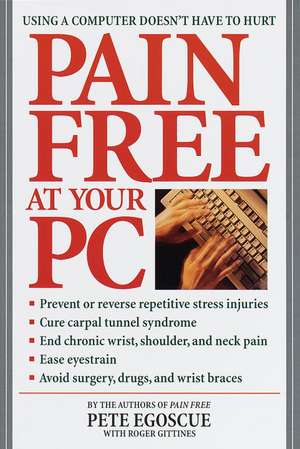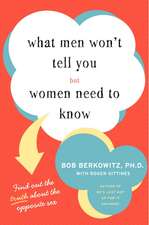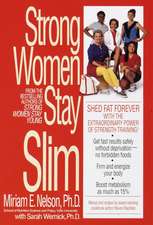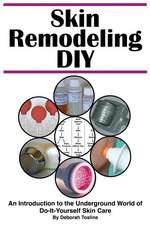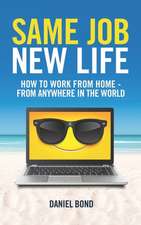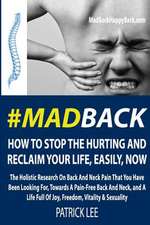Pain Free at Your PC
Autor Pete Egoscue Ilustrat de Wendy Wray Roger Gittinesen Limba Engleză Paperback – 31 oct 1999
Prevent or reverse repetitive stress injuries
Cure carpal tunnel syndrome
End chronic wrist, shoulder, and neck pain
Ease eyestrain
Avoid surgery, drugs, and wrist braces
Using a computer should challenge your mind, not your body.
As computers become a larger part of our daily lives both at work and at home, complaints of painful wrists, sore shoulders, stiff necks, and blurry vision associated with computer use continue to soar.
But the good news is that this chronic pain can easily be prevented or cured without surgery or drugs--or expensive "ergonomic" equipment. There's no need to move your monitor, wear wrist braces, or sit in a specially designed chair.
Instead, Pete Egoscue, using the techniques and principles developed at his renowned clinic, shows you how to keep pointing and clicking for hours--pain free.
You'll learn how to:
Avoid or treat common but debilitating repetitive stress injuries, including carpal tunnel syndrome
Recognize and remedy problems in posture and movement before they cause pain
Do easy-to-perform exercises at your desk to eliminate chronic hand, wrist, shoulder, back, and neck pain
Quickly and easily correct damaging patterns of motion
And much more
Preț: 109.13 lei
Nou
Puncte Express: 164
Preț estimativ în valută:
20.88€ • 22.75$ • 17.60£
20.88€ • 22.75$ • 17.60£
Carte disponibilă
Livrare economică 02-16 aprilie
Preluare comenzi: 021 569.72.76
Specificații
ISBN-13: 9780553380521
ISBN-10: 0553380524
Pagini: 208
Dimensiuni: 153 x 229 x 14 mm
Greutate: 0.29 kg
Ediția:New.
Editura: Bantam
ISBN-10: 0553380524
Pagini: 208
Dimensiuni: 153 x 229 x 14 mm
Greutate: 0.29 kg
Ediția:New.
Editura: Bantam
Notă biografică
An anatomical physiologist, Pete Egoscue has worked with hundreds of clients who had pain associated with computer use. He has also been consulted by some of the biggest names in sports. Practicing full-time since 1978, he is now working out of his clinic in San Diego, California. He is the co-author of Pain Free, along with Washington, D.C.-based writer Roger Gittines.
Extras
The PC--From Painful to Pain Free
"It's a deal. Let's shake on it."
"I can't, my wrist hurts."
"Hah! I told you that was going to happen."
"I know, but my career's golden. I'm on the cutting edge."
"Cutting edge? High-tech hell is more like it."
"I'm going to try a wrist splint. I've got a shinbone of a musk ox I can use."
"Try getting another job. Your wrist is always going to hurt. Humans weren't designed to swing a hammer all day. Your basic rock was good enough."
Musk ox? Hammer? A quick visit to a Pleistocene valley startup? Sorry for the cheap trick, but it probably worked. I know you saw right through me, but many other readers thought I was referring to that dreaded public health menace, the personal computer--wrecker of wrists, despoiler of eyesight, inflamer of elbows, cricker of necks, and begetter of headaches.
And now I am in more trouble because it may seem like I'm being unsympathetic to people experiencing agonizing pain. But on that charge, as someone who's spent almost every day of nearly the last thirty years helping those suffering from chronic musculoskeletal pain, I plead not guilty. Millions of men, women, and children are hurting. The sleepless nights are real, as is the inability to tie shoelaces and the struggle to surmount the wall of pain that stands in the way of pointing and clicking with a mouse or tapping the space bar of a keyboard with a thumb. Likewise, the stiff necks and nauseating headaches destroy productivity and any sense of a job well done.
No, I'm deeply sympathetic to those in chronic pain. I've been there myself, and my search for a cure to relieve my pain led to the formulation of a therapeutic method, the Egoscue Method, that is now known worldwide as a remarkably successful alternative to drastic drug and surgical treatments or gimmicky "ergonomic" solutions that do more harm than good.
My point about the PC and the hammer is this: Just as it would be wrong to blame the hammer for the aches and pains that beset workers from the era of the caveman to the cabinetmaker, the coal miner to the carpenter, it's a mistake to think that the personal computer is responsible for the variety of conditions that are being labeled "computer pain syndrome."
The term is as inapt as hammer pain syndrome, fountain pen pain syndrome, or microscope pain syndrome. These are tools, not diseases. We've flourished as toolmakers and tool users--our tools are blameless. Certainly, accidents happen on the job. Safety must always be a priority, although it frequently isn't. But to treat a tool--any tool, high tech or low--as the source of an epidemic is something new and profoundly disturbing.
Whatever pain you may be feeling, it is not caused by your PC. And it cannot be cured by reinventing the PC or the way you use it. There is a remedy, though, and that's what this book is all about.
Pain Free at Your PC challenges conventional wisdom with what I regard to be the most persuasive and conclusive body of evidence--the human body. Being pain free at your PC is as natural and attainable as a pain-free night's sleep or a pain-free day of hard work. Our hands and wrists are inherently strong enough to operate a keyboard and a mouse for hours on end. Human necks, heads, and eyes can take the stress and strain too.
So what's the problem? Why is the federal government describing repetitive stress injuries (RSIs) as a workplace "epidemic"?
Why is the incidence of carpal tunnel syndrome (CTS) and other forms of chronic pain associated with computer use rising dramatically?
Why are we quick to blame this valuable new tool?
The answer is that a search for the cause of computer-related pain has veered off course and locked onto the effect instead. Let me filter this predicament through an observation I made early in my career as a therapist: The true source of chronic musculoskeletal pain is rarely the site of the pain. That means if your wrist hurts while you are pointing and clicking with a mouse, the pain probably has nothing to do with the device, and everything to do with muscular weakness, skeletal misalignment, and structural (joint) instability elsewhere in the body. Those conditions can be reversed without drastic measures--and you can do it yourself.
I've also learned that muscular weakness, skeletal misalignment, and structural instability usually precede the onset of pain that is attributed to accidents, overuse, or aging. That's right, precede. And that means we're ignoring the real cause of the pain when we tinker with the PC or the mouse, replace the chair, brace the wrist, or surgically remove the transverse carpal ligament (the usual CTS surgical procedure). The symptoms may abate temporarily because peripheral conditions have changed, but the pain usually returns or shifts to another spot. We're better off retracing our steps to correct--here's the chorus again--muscular weakness, skeletal misalignment, and structural instability. Just call them dysfunctions to save time.
Remembering to Forget
It's easy to draw the wrong conclusion about PCs when cause and effect get jumbled around. The PC seems to be placing an inordinate demand on our physical functions by asking us to move our fingers, hands, wrists, and arms again and again. And that's true. But it's only because we come to the PC expecting to use muscles and joints that were drained of much of their strength and flexibility long before Bill Gates made his first billion dollars. As modern specialists, we are now using special tools under special conditions. In itself that's no problem. Amnesia is the problem. We forget that our bodies evolved in service to the all-purpose, multifaceted work and lifestyles of a species of magnificent generalists. By remembering where we came from and who we are, we can forget the pain.
The musculoskeletal system is a virtual historical textbook chronicling the varied and demanding everyday movements required of humankind for millions of years. Look at it. Look at yourself. The erect spine and the rugged shoulders, the solid hips and the hard-driving knees, the sturdy ankles, tough feet, and clever hands are all chapters of a success story about creatures who could not keep still.
As an exercise therapist, when I "read" the text, I see an integrated, balanced unit of muscles and joints that must be fed or refueled in its entirety by motion. Although the world has changed, the musculoskeletal system remains the same--still magnificent, still a generalist after all those years. Our specialized work, however, restricts and limits motion to the relatively few muscles and joints that are directly involved. Even our recreational activity is specialized. Relatively few muscles work and play; all the rest languish.
Surgery, drugs, and ergonomic redesign do not address this fundamental source of chronic musculoskeletal pain.
Hardworking fingers, wrists, and hands cannot be isolated from nonworking (or minimally working) hips, knees, ankles, and their supporting musculature without painful consequences. The necessary mechanical and muscular interaction is lost. As a result, our integrated bodies are disintegrating and being deconditioned--not by the PC but by the TV, the CD, the RV, and all the other "A to E-Z" accoutrements of modern living. Our bodies are in trouble before we even sit down at the computer keyboard. Overall lack of motion and highly restricted specialized motion are the culprits. I'll explain the phenomenon in the remainder of this chapter and in chapters 2 and 3. After addressing the whys, the book will focus on what--what you can do about it quickly and easily.
And that's both good and bad news. Good because there is a solution; bad in that it requires a personal commitment to make small but significant changes in the way you live and work. Frankly, it's probably a bad idea to acknowledge this downside. Many people are turned off by the notion that they won't be able to buy good health just like any other product. Surgery, painkilling drugs, and products like ergonomic keyboards, wrist braces, and special desk chairs hold the promise of a quick fix. As dedicated consumers, we tend to believe we can purchase nearly anything that's needed ready-made and right off the shelf. Unfortunately, the human body doesn't work that way.
Did I use the word unfortunately? Actually, this is an entirely fortunate situation. Bones, joints, muscles, tendons, and ligaments maintain and sustain themselves on the go. All we have to do is go and keep going. The changes in your work and lifestyle that this book promotes are designed to take the stops out.
"It's a deal. Let's shake on it."
"I can't, my wrist hurts."
"Hah! I told you that was going to happen."
"I know, but my career's golden. I'm on the cutting edge."
"Cutting edge? High-tech hell is more like it."
"I'm going to try a wrist splint. I've got a shinbone of a musk ox I can use."
"Try getting another job. Your wrist is always going to hurt. Humans weren't designed to swing a hammer all day. Your basic rock was good enough."
Musk ox? Hammer? A quick visit to a Pleistocene valley startup? Sorry for the cheap trick, but it probably worked. I know you saw right through me, but many other readers thought I was referring to that dreaded public health menace, the personal computer--wrecker of wrists, despoiler of eyesight, inflamer of elbows, cricker of necks, and begetter of headaches.
And now I am in more trouble because it may seem like I'm being unsympathetic to people experiencing agonizing pain. But on that charge, as someone who's spent almost every day of nearly the last thirty years helping those suffering from chronic musculoskeletal pain, I plead not guilty. Millions of men, women, and children are hurting. The sleepless nights are real, as is the inability to tie shoelaces and the struggle to surmount the wall of pain that stands in the way of pointing and clicking with a mouse or tapping the space bar of a keyboard with a thumb. Likewise, the stiff necks and nauseating headaches destroy productivity and any sense of a job well done.
No, I'm deeply sympathetic to those in chronic pain. I've been there myself, and my search for a cure to relieve my pain led to the formulation of a therapeutic method, the Egoscue Method, that is now known worldwide as a remarkably successful alternative to drastic drug and surgical treatments or gimmicky "ergonomic" solutions that do more harm than good.
My point about the PC and the hammer is this: Just as it would be wrong to blame the hammer for the aches and pains that beset workers from the era of the caveman to the cabinetmaker, the coal miner to the carpenter, it's a mistake to think that the personal computer is responsible for the variety of conditions that are being labeled "computer pain syndrome."
The term is as inapt as hammer pain syndrome, fountain pen pain syndrome, or microscope pain syndrome. These are tools, not diseases. We've flourished as toolmakers and tool users--our tools are blameless. Certainly, accidents happen on the job. Safety must always be a priority, although it frequently isn't. But to treat a tool--any tool, high tech or low--as the source of an epidemic is something new and profoundly disturbing.
Whatever pain you may be feeling, it is not caused by your PC. And it cannot be cured by reinventing the PC or the way you use it. There is a remedy, though, and that's what this book is all about.
Pain Free at Your PC challenges conventional wisdom with what I regard to be the most persuasive and conclusive body of evidence--the human body. Being pain free at your PC is as natural and attainable as a pain-free night's sleep or a pain-free day of hard work. Our hands and wrists are inherently strong enough to operate a keyboard and a mouse for hours on end. Human necks, heads, and eyes can take the stress and strain too.
So what's the problem? Why is the federal government describing repetitive stress injuries (RSIs) as a workplace "epidemic"?
Why is the incidence of carpal tunnel syndrome (CTS) and other forms of chronic pain associated with computer use rising dramatically?
Why are we quick to blame this valuable new tool?
The answer is that a search for the cause of computer-related pain has veered off course and locked onto the effect instead. Let me filter this predicament through an observation I made early in my career as a therapist: The true source of chronic musculoskeletal pain is rarely the site of the pain. That means if your wrist hurts while you are pointing and clicking with a mouse, the pain probably has nothing to do with the device, and everything to do with muscular weakness, skeletal misalignment, and structural (joint) instability elsewhere in the body. Those conditions can be reversed without drastic measures--and you can do it yourself.
I've also learned that muscular weakness, skeletal misalignment, and structural instability usually precede the onset of pain that is attributed to accidents, overuse, or aging. That's right, precede. And that means we're ignoring the real cause of the pain when we tinker with the PC or the mouse, replace the chair, brace the wrist, or surgically remove the transverse carpal ligament (the usual CTS surgical procedure). The symptoms may abate temporarily because peripheral conditions have changed, but the pain usually returns or shifts to another spot. We're better off retracing our steps to correct--here's the chorus again--muscular weakness, skeletal misalignment, and structural instability. Just call them dysfunctions to save time.
Remembering to Forget
It's easy to draw the wrong conclusion about PCs when cause and effect get jumbled around. The PC seems to be placing an inordinate demand on our physical functions by asking us to move our fingers, hands, wrists, and arms again and again. And that's true. But it's only because we come to the PC expecting to use muscles and joints that were drained of much of their strength and flexibility long before Bill Gates made his first billion dollars. As modern specialists, we are now using special tools under special conditions. In itself that's no problem. Amnesia is the problem. We forget that our bodies evolved in service to the all-purpose, multifaceted work and lifestyles of a species of magnificent generalists. By remembering where we came from and who we are, we can forget the pain.
The musculoskeletal system is a virtual historical textbook chronicling the varied and demanding everyday movements required of humankind for millions of years. Look at it. Look at yourself. The erect spine and the rugged shoulders, the solid hips and the hard-driving knees, the sturdy ankles, tough feet, and clever hands are all chapters of a success story about creatures who could not keep still.
As an exercise therapist, when I "read" the text, I see an integrated, balanced unit of muscles and joints that must be fed or refueled in its entirety by motion. Although the world has changed, the musculoskeletal system remains the same--still magnificent, still a generalist after all those years. Our specialized work, however, restricts and limits motion to the relatively few muscles and joints that are directly involved. Even our recreational activity is specialized. Relatively few muscles work and play; all the rest languish.
Surgery, drugs, and ergonomic redesign do not address this fundamental source of chronic musculoskeletal pain.
Hardworking fingers, wrists, and hands cannot be isolated from nonworking (or minimally working) hips, knees, ankles, and their supporting musculature without painful consequences. The necessary mechanical and muscular interaction is lost. As a result, our integrated bodies are disintegrating and being deconditioned--not by the PC but by the TV, the CD, the RV, and all the other "A to E-Z" accoutrements of modern living. Our bodies are in trouble before we even sit down at the computer keyboard. Overall lack of motion and highly restricted specialized motion are the culprits. I'll explain the phenomenon in the remainder of this chapter and in chapters 2 and 3. After addressing the whys, the book will focus on what--what you can do about it quickly and easily.
And that's both good and bad news. Good because there is a solution; bad in that it requires a personal commitment to make small but significant changes in the way you live and work. Frankly, it's probably a bad idea to acknowledge this downside. Many people are turned off by the notion that they won't be able to buy good health just like any other product. Surgery, painkilling drugs, and products like ergonomic keyboards, wrist braces, and special desk chairs hold the promise of a quick fix. As dedicated consumers, we tend to believe we can purchase nearly anything that's needed ready-made and right off the shelf. Unfortunately, the human body doesn't work that way.
Did I use the word unfortunately? Actually, this is an entirely fortunate situation. Bones, joints, muscles, tendons, and ligaments maintain and sustain themselves on the go. All we have to do is go and keep going. The changes in your work and lifestyle that this book promotes are designed to take the stops out.
Recenzii
"Straight talk...brilliant insights...an important book for all of us."
--James V. Kimsey, founding CEO and chairman emeritus of AOL Inc.
--James V. Kimsey, founding CEO and chairman emeritus of AOL Inc.
Descriere
Computer work doesn't have to be a pain in the neck, or anywhere else. This revolutionary book shows how the aching millions can learn to apply the Egoscue Method to be pain free at their PCs.
